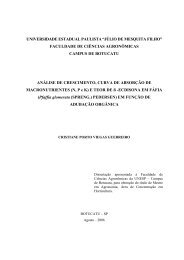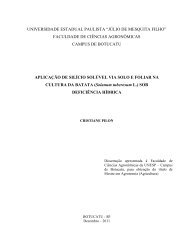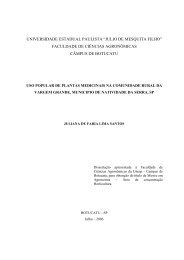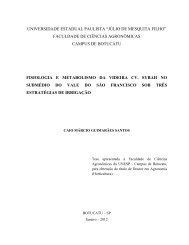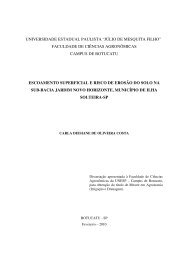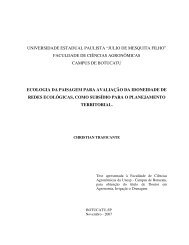PRODUÃÃO DE VINHO DE UVAS DOS CULTIVARES NIÃGARA ...
PRODUÃÃO DE VINHO DE UVAS DOS CULTIVARES NIÃGARA ...
PRODUÃÃO DE VINHO DE UVAS DOS CULTIVARES NIÃGARA ...
Create successful ePaper yourself
Turn your PDF publications into a flip-book with our unique Google optimized e-Paper software.
XI<br />
hedonic scale, and quantitative descriptive wine analysis. The use of Bordô wine for<br />
assemblage with Niagara Rosada wine resulted in a beverage with more balanced<br />
physicochemical characteristics concerning acidity, dry extract content, and reduced dry<br />
extract, alcohol/reduced dry extract relation, polyphenol content, and coloration. There was no<br />
significant statistical difference (p• 0.05) in the acceptance test as for global acceptance,<br />
flavor, and aroma of different treatments, although the appearance acceptance was higher for<br />
more intense coloration treatments. In quantitative descriptive analysis, 13 descriptive terms<br />
were chosen to describe similarities and differences between samples: red and golden-yellow<br />
coloration, transparency, grape, alcohol, artificial grape and acid aromas, acid taste, dry, grape<br />
juice and alcohol flavor, astringency, and body. The used descriptors were adequate for<br />
sample discrimination, except the alcohol aroma one which did not show significant statistical<br />
difference for the analyzed wines. The pomace, which is usually used as a source of nutrients<br />
in the vineyard, was distilled for ethanol recovery before its final use in the field. Ethanol<br />
recovery was higher for Niagara grape distilled than for Bordô grape; these results are justified<br />
by the higher sugar content in Niagara Rosada grape what contributes to higher alcohol<br />
concentration in the pomace.<br />
Keywords: Vitis labrusca, enology, quantitative descriptive analysis.



